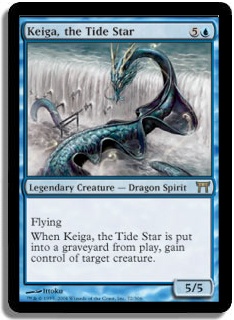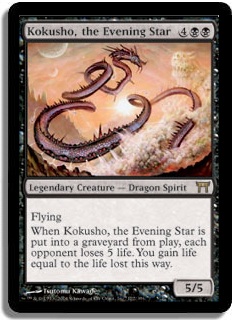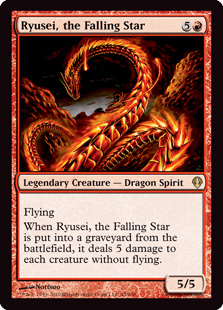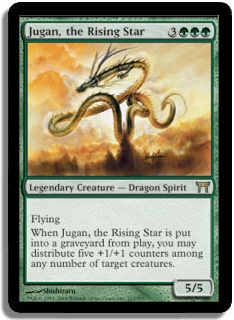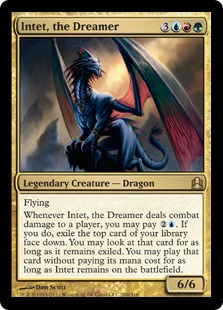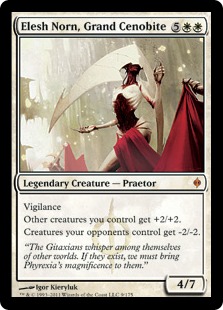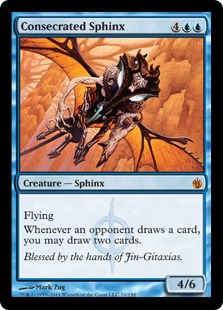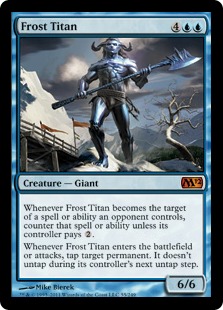Finishers (creatures that cost six or more mana) are powerful win conditions that midrange and control decks use to not only help themselves stabilize
in the later stages of the game, but also serve as the main conditions of victory. In this article, I’ll be discussing the importance of these
creatures in cube and how to evaluate and utilize them for your cube.
First of all, why are finishers defined to be creatures which have a cost of six or above? Why not four or five?
Historically, six mana has been seen as the mana cost for Magic’s big finishers, mainly dragons—cards like Shivan Dragon (and Mahamoti Djinn, an
honorary dragon) from Alpha, the Mirage dragons like Mist Dragon and Catacomb Dragon, and the Invasion tri-color dragons like Rith, the Awakener
defined six mana as “dragon mana,” the point to which decks would accelerate and ride the win condition to victory. Other cycles of
finishers like Onslaught’s pit fighter legend cycle (Jareth, Leonine Titan; Arcanis the Omnipotent; Visara the Dreadful; Rorix Bladewing and
Silvos, Rogue Elemental) continued the tradition of finishers at six mana. Many of Magic’s early finishers were weak and inefficient, most
notably the overcosted creatures like Mold Demon and Elder Land Wurm which somehow had drawbacks in addition to their horribly inefficient bodies.
Much like how four is an important mana threshold as was stated in a previous article, so is six—as six mana is the point where aggro and
midrange decks seek to have the opponent in lower life totals and control decks seek to gain control of the game (and aggro should be thinking about
ending the game around turn six or shortly after). Because of this, the role of finishers isn’t nearly as important for aggro decks as they are for
control decks unless they’re as curve-toppers that seek to end the game shortly after—cards like Triskelion, Inferno Titan, Frost Titan (in
aggressive blue decks) and Sun Titan are the fare of aggro decks as opposed to Wurmcoil Engine, Keiga, Yosei and Crater Hellion.
There are several criteria to take into account when considering cube finishers.
Strong abilities and a non-ignorable power/toughness
Many finishers are useful in cube because they have strong abilities that define their impact, like Grave Titan’s ability to create a horde of
zombies. There are creatures in cube that are great because of their efficiency in pure power and toughness (Isamaru, Hound of Konda, Tarmogoyf) but
cube finishers are more defined by their abilities than they are by their power and toughness, although that certainly does play an important
role—when Bloodgift Demon was initially thought to be a 4/4 flier instead of a 5/4 flier, people did not think that it was a very good card
despite its powerful Phyrexian Arena-esque ability, but a point of power made all of the difference in the world. Even in the game’s early days,
creatures like Hypnotic Specter and Gorilla Shaman were similarly defined not because they had efficient bodies, but because they had powerful effects
that emulated spells.
This can be seen by looking at some of the older cube finishers, such as:
Desolation Angel (which is really a 7 mana creature)
With the exception of Exalted Angel (which is really a 3 + 4 mana creature), all of the above creatures are used in cube because of their powerful
spell-like abilities like Armageddon on Desolation Angel, Slice and Dice/Starstorm on Crater Hellion and Arc Lightning on Triskelion.
However, if you look at cube lists, you’ll notice that many of the finishers have the Modern card face, as finishers started to get better around
the time of the new card face, especially the Kamigawa block’s legendary dragon cycle. Cards like Keiga, Kokusho and Yosei added a unique
element: all of them provided a useful effect when they died (whereas many of the other old finishers like the members of the Onslaught pit fighter
cycle or the Invasion tri-color dragon cycle didn’t really do anything when they died,) and saw extensive play because of their ability to allow the
caster to tap out for a big effect and not have to fear being blown out by a timely removal spell.
Granted, Jugan and Ryusei didn’t really make much of an impact in cube because of their awkward abilities (and in the case of Jugan, an awkward
mana cost,) but the other dragons were useful enough through their death triggers to make the Esper-aligned ones cube staples for years and the fact
that people have been considering taking these powerful finishers out of their cube is testament to how many powerful finishers have been printed
lately.
The need for cube-worthy finishers to have a powerful “impact” and return on investment is also important considering that cheating
creatures into play is a favorite strategy amongst cube players as the powerful impact is that much more powerful if the creature comes into play on
something like turn four or earlier.
The cube staple finishers like Myr Battlesphere, Grave Titan and Woodfall Primus are all very good examples of creatures with a powerful effect and a
body that can’t be ignored—the problem with finishers that lack evasion and do not have an immediate impact like Kalonian Behemoth and
Plated Slagwurm is that, while they have large bodies, they can usually be ignored by just chump blocking the non-evasive monsters all day and having
little return given on the mana investment.
Protection – The Terminate/Vindicate test
A creature being able to provide value even when the creature dies immediately after is commonly referred to as “the Terminate test.”
Considering how much cheap removal there is in cube, being able to provide postmortem value is key.
Instead of using the “Terminate test” which relies on a creature being able to get value even if the creature gets removed at instant
speed, I’ll be using the “Vindicate test” (which instead judges a creature’s strength on the value gained from the creature if
it’s removed at sorcery speed) as it represents a more accurate picture of how a creature provides value in cube for midrange and control decks.
I’ve measured the ways that my cube has to deal with creatures at instant speed and sorcery speed (to err on the side of caution, I decided to
not put any restrictions on the removal spells—almost no finishers will die to a Magma Jet but spells like that are included for this). In my
450-card cube there are 28 ways to deal with creatures at instant speed compared to the 77 ways at sorcery speed, 275 percent more than the instant
ways to deal with it. Your cube’s mileage may vary slightly, but the overall effect should bear out to be pretty similar, there are many more
ways to deal with creatures at sorcery speed than there are at instant speed. We may remember the times when we cast a creature only for it to die to a
Path to Exile or Swords to Plowshares, but the reality is that creatures in cube die much more often during the main phase than at EOT.
Finishers with ways to protect themselves have been generally strong finishers as they can be usually deployed without having to worry about protecting
them—“set it and forget it.” It can also help going “all in” on a finisher when trying to stabilize, making sure that the
creature doesn’t just get dealt with for no value gained.
The Vindicate test can also be applied to non-creature effects, though there are fewer removal effects for non-creatures than there are for creatures.
Cards like Debtors’ Knell, for example, used to be staples in cubes for ages because of weak competition in white and black. Much like how stronger
competition in the tri-color cards kicked out the Invasion dragons, so did competition in black-white and cubes overall becoming tighter. This made it
so that the overall effect from Debtors’ Knell changed—you couldn’t expect it to take over the game as much as it used to and thus
its overall power dropped. This made cards like Debtors’ Knell that failed the Vindicate test fall out of favor in many cubes, because even
though the potential for Debtors’ Knell to take over the game was there, the overall effect was weaker than other cards.
A similar thing happened with Mindslaver—a card with very powerful potential upside that provides no initial impact when cast for six
mana—as stronger cards in the Scars of Mirrodin block kicked Mindslaver out of many cubes. It was just too slow and tapping out for it on turn 6
wasn’t worth it when compared to other new cards like Wurmcoil Engine.
As mentioned earlier, with control decks relying on their six-plus mana creatures to stabilize, they seek to gain a return on their investment; if
they’re tapping out on turn six to try to stabilize with a finisher and eventually win with it, it’d be a terrible fate for the creature to just die
without much return on the mana investment aside from the opponent spending a card and a bit of mana on the effort. The Vindicate test can
show how some finishers don’t provide enough return on the mana investment to be cube-worthy.
As many cubes were based around the cubes in Ontario that had one of each tri-color card, many of them resorted to using the weaker tri-color dragons
(from Invasion and when Planar Chaos) because of the lack of options—RUG was particularly bad as it had to choose between Guided Passage, Intet,
the Dreamer, Cetavolver and Ceta Disciple (none of which were very good). However, as the “best of the bad,” many cubes used cards like
Intet, the Dreamer and Oros, the Avenger.
So why were those cards bad, exactly? Think back to the Debtors’ Knell/Mindslaver example. Even if someone could untap with one of the tri-color
dragons and have its trigger happen, its overall power was low, especially when compared to single and double colored finishers. Looking at overall
power can be very hard to do and one of the problems with the Vindicate test is that it can be easy to exaggerate the potential worst-case scenario of
finishers. Consider the following:
When people initially evaluated these creatures using the Vindicate test as a metric, these creatures were dismissed as bad because their value seemed
weak according to the metric. “Kill some random chump blockers, draw a few cards or tap something that’ll just end up untapping? Why should I
bother with these when cards like Keiga or Kokusho fare much better with the Vindicate test?”
The problem when using only the Vindicate test as a measure is that it doesn’t look at the overall picture of a finisher’s potential
performance, only its weakest. One of the useful things about the Vindicate test is that it can be an easy way to evaluate a card but that
doesn’t mean that it’s necessarily correct, as theoretically looking at the value of a finisher can be hard to do. For example, how often
does Frost Titan just tap something and then die without impacting the board? How often does it give you an out versus a troublesome permanent for many
turns? How often does Consecrated Sphinx immediately die to removal? How often does it draw a ton of cards? What is the average number of cards drawn
with Consecrated Sphinx? Using the Vindicate test doesn’t help with these questions, all it really does is say “this worst-case scenario
can happen,” but it doesn’t say how often that happens.
In formats like Standard, singular cards can define how cards play out. Thornling was hardly played during its time in Standard because it had the
unfortunate circumstance of being in the same set as Path to Exile, and Hero of Bladehold saw little play because of the omnipresence of Jace, the Mind
Sculptor. While there are redundant effects in cube—a black section not only has Dismember, but also Snuff Out, Go For The Throat,
Diabolic/Chainer’s Edict and many more “187” creatures—there still isn’t the density for decks to be able to have the same
consistency for removal effects that they do in constructed formats. Even with the amount of creature-removal effects available in cube, it still
isn’t easy to reach that same density of removal in cube that you would in a Constructed formats. Therefore, the “dies to cheap
removal” argument doesn’t render finishers like Consecrated Sphinx and Frost Titan weak, because it does not take into consideration the overall
impact and benefit from those blue finishers. Sometimes, it can be difficult to really tell the overall impact of a card—people initially
dismissed Baneslayer Angel (not just for cube, but in general)—because both fail the vindicate test. However, through using the cards, people
realized that the Vindicate test wasn’t the be-all-end-all of card evaluation and that while Baneslayer Angel sometimes died to a timely removal
spell, that didn’t look at the card’s value from a holistic point of view. While Baneslayer Angel’s worst-case scenario did certainly
happen in both Constructed and in cube, she more often swung for 5 lifelink, first strike damage than she died to a removal spell like a Doom Blade or
Day of Judgment and it’s important to keep the overall power level in mind.
Non-rare cube and finishers
For non-rare cubes, finishers are in an odd position. At the beginning of this article, I talked about how many of the best cube finishers are recently
printed, but another factor is that almost all of the best finishers in cube are rare, putting rareless cubes in an odd spot. It’s highlighted
further because a lot of the cube-worthy cheap removal remains intact, especially in uncommon/common cubes which keep the best removal effects like
Swords to Plowshares, Path to Exile, Dismember and Snuff Out. Even common cubes retain a lot of the best red burn effects (Lightning Bolt,
Staggershock) and a lot of the black and white two-mana removal effects.
As almost all of the cube-worthy finishers have five-plus power and evasion, many potential finishers at the non-rare slot don’t fit that
criteria; to the point where uncommon/common cubes are completely justified in considering Death by Dragons, even if it just creates a French vanilla
5/5 flier for 4RR. If you think that’s awkward, many of the finishers for rareless cubes look abysmal compared to traditionally used ones in
“rare” cubes: staple uncommon finishers include cards like Sengir Vampire, Changeling Hero, Jetting Glasskite and Firemaw Kavu, and if you
think that’s weird, staple common finishers include Ulamog’s Crusher, Halimar Wavewatch, Havenwood Wurm and Noble Templar.
Both common and uncommon/common cubes have some cards that pass the Vindicate test (Serra Angel fails it, Firemaw Kavu passes it, Aethersnipe passes
it, Halimar Wavewatch fails it) but it may be another example that shows that the Vindicate test isn’t as ironclad as it may seem—Serra
Angel and Sengir Vampire are common/uncommon cube staples, even if there are other powerful removal effects like Path to Exile and Swords to Plowshares
in the format. In my common cube, I started adding more finishers like Kavu Primarch and Plover Knights because even if they do fail the Vindicate
test, they will provide enough of an overall effect and impact to make them cube-worthy finishers in my common cube because other finishers like
Flowstone Crusher and Castle Raptors that fail the Vindicate test are still good enough for that environment because of their overall impact and power
level.
When evaluating finishers for a cube, it’s vitally important to realize that because control and midrange decks are the ones that mainly use
finishers and even they don’t use that many in their decks – it’s important to not only monitor the number of finishers in your cube to not
overly represent control and midrange decks, but to also make sure that you critically evaluate the power level and role of each finisher in your cube.
One of the ways to help aggressive decks is to make sure that sections aren’t overburdened with control finishers, as it’s hard for
aggressive decks to thrive in a white section using weak finishers like Crovax, Ascendant Hero and Admonition Angel over cards like Steppe Lynx and
Cloistered Youth.
All in all, when you’re designing and drafting a cube, you want your finishers to have a powerful effect on the board. In the grand scheme of
things, this is the most important thing for a cube finisher–if you’re spending a lot of mana for a finisher in your cube, the overall benefit
should be good enough to justify tapping out for it.
May all of your opening packs contain Sol Rings!
@UsmanTheRad
on Twitter
My blog featuring my cube lists: http://idratherbecubing.wordpress.com
Cube podcast that Anthony Avitollo and I
co-host: The Third Power


